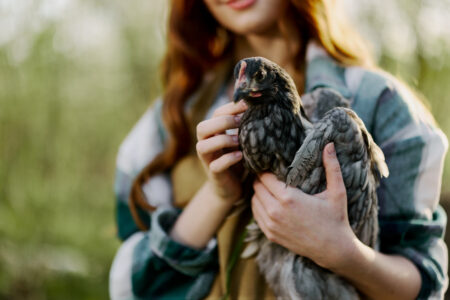During my years of wishing for a simpler life, I romanticized some aspects of country living. This was probably because I had a great childhood growing up on a hobby farm. I had chores, but not to the extent that other “real” farm kids had. I had plenty of time for fishing, reading, and exploring the woods with my dog. No wonder I wanted to get back to that!
As an adult responsible for livestock, it sometimes seems that the simple life can be complicated. Case in point: We have about eight acres of woods beyond the barn, and from everything we had read about goats, this seemed like the perfect place for them. They could eat briars and weeds, cutting down on our hay expenses. That hasn’t quite panned out, in part because of a poisonous weed known as white snakeroot (WSR). It grows well here, because it likes woodlands and undisturbed areas. Our property has hills and hollers thick with trees and brush; maybe someday we’ll let some feeder pigs tame a portion of it, but until then we harvest firewood and otherwise let it be. Thus the snakeroot flourishes.
Photo: White Snakeroot (Ageratina altissima) | Wikimedia Commons/Fritzflohrreynolds
The leaves, stems and flowers of this plant contain a toxin called tremetol, and if animals eat too much of it, it’s fatal. The toxin concentrates in the meat and milk of grazers/browsers. A lactating animal actually has a little protection from it because it moves quickly into her milk; consequently, her nursing babies can be poisoned, as well as humans who drink the milk. Pasteurization does not neutralize tremetol, and neither does frost. “Milk sickness” killed many settlers in the Ohio River Valley in the 1800s. History tells us that Abraham Lincoln’s mother, Nancy Hanks Lincoln, died of it when Abe was 11 years old. At that time, people were terrified because no one knew what was causing these deaths among animals and people. Finally, a frontier doctor named Anna Pierce Hobbs Bixby documented the connection between the deaths and WSR, after a Shawnee woman (name now unknown) told her about the plant’s effects.
Goats are browsers, meaning they eat some of this, a little of that, then move on and find some other things to try. They eat weeds, brush and briars that cows and sheep don’t like. They really like tree leaves, and will stand on their hind legs to nibble on foliage at and above head level. Our goats don’t venture too far from the barn unless we go with them, but when they eat near ground level, I have seen them take an occasional bite of WSR. While I don’t worry about most of our goats ingesting too much, I don’t want to take any chances with our milker. Since July, I only let the does out of the barnyard for a bit in the evenings, while I supervise. Truth be told, they tend to stay around the wood deck, nibbling bark off of logs. They are also fascinated with Lowell’s hammock, so by the time I’m ready to put them up, they haven’t ventured out into the greenery too much, anyway! Crazy goats.
While reading online, I found a helpful article on the blog Distracted Naturalist. I discovered that we have a lot of something called clearweed here, which resembles WSR in some ways. When our milker nibbles greens, she sometimes chooses that. Good girl, Focus, but I’m still going to supervise you carefully.
Clearweed
In summary:
1. Don’t take chances if your goats are used for meat or milk. If you have this plant on your property, do your research and decide how you will manage it. You can hand-pull the plants if practical. Some people use herbicides; others restrict their animals from the plants’ location, from July until the next spring.
2. My reading said that toxic levels can build up from either a single large feeding, or several smaller ones ingested over time.
3. I did not find a milk withdrawal time for WSR; does anyone know the answer?
4. Most grazers and browsers tend to avoid WSR if tastier fare is available.
5. Educate yourself about look-alike plants. That has saved me some late-night fretting after a walk with the goats!
6. It’s easier to identify this plant when it starts blooming in late summer.
7. On a positive note, snakeroot’s clusters of white flowers, which bloom at the top of the plant, provide late-season food for pollinators.
Milking a goat is part of the lifestyle we enjoy here. Learning about white snakeroot resulted in some adjustments to our overall goat management plan. Yep, the simple life is rewarding, but it can also be complicated!









